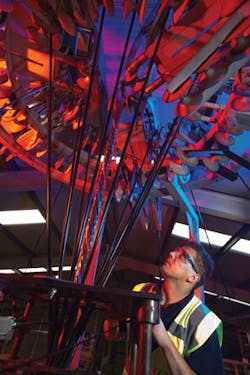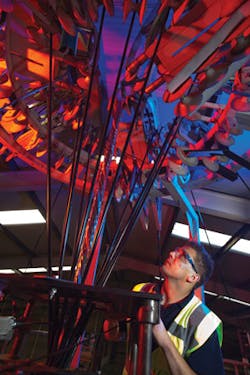Higher-pressure hoses broaden intervention options
Lightweight construction suited to reel deployment
James Young
JDR
As the industry emerges from the recent period of capital constraints, conversations about the future are taking on a more positive tone. It is still early days, but with the need for more power to be delivered to the seabed for subsea processing, innovation in this field has a more secure place on the strategy agenda.
New technology developments are making deepwater reservoirs potentially viable that were previously considered inaccessible. One example is the emergence of higher-pressure hoses for intervention work-over control systems (IWOCS) umbilicals and well-bay risers. IWOCS umbilicals, which have been around for more than 30 years, contain hydraulic control and chemical injection lines and electrical cables. They perform a vital role in initiating and then improving well performance.
Over the past 15 years, industry-standard IWOCS umbilicals have been used to maintain control of valves at the seabed on christmas trees during various stages of start-up operations for a well or field, or throughout the field’s life to perform well access activities. These lightweight, highly flexible umbilicals rely on control lines that can withstand up to 15,000 psi (1,034 bar) internal pressure in the flexible hoses.
However, as the industry sets its sights on reserves in ever-deeper waters or locations with much greater step-out distances, the 15K industry-standard is becoming one of the constraining factors for new well development. Operators now need IWOCS umbilicals that can open a valve against much higher reservoir back pressures typically encountered in deeper waters, or to handle the pressure required to pump oil across much longer distances. Demand has therefore been growing for 20,000 psi (1,379 bar) pressure functionality within IWOCS umbilicals.
JDR is working to meet this requirement with a new-generation hose design that is currently in the final stages of critical testing. Last year the company successfully qualified a hose capable of withstanding 17,500 psi (1,206 bar) as an intermediate pressure class.
The key to making both 17,500 and 20,000 psi hoses viable has been in materials development. While high-pressure spiralized, steel-reinforced hoses have been used in intervention and workover control applications in the past, these steel-reinforced solutions inevitably resulted in a heavier umbilical, increasing the deck-weight required for the umbilical and its deployment reeler or winch.
In contrast, the new generation of high-pressure hoses consist of a polymer liner reinforced with a woven material made of strong, high performance synthetic fibers, with an extruded nylon or polyethylene jacket to complete the lighter-weight hose construction. There have also been significant improvements to the design of end couplings in order to maximize pressure containment and achieve the higher working pressures.
The potential advantages of the new generation of high-pressure hoses are wide-ranging. They can be stored and transported on reelers that themselves are smaller and lighter, occupy a much smaller deck footprint and require much less infrastructure to support their weight. That increases the range of vessels that can be used and consequently assists in reducing the cost of vessel operations. Operators can therefore cut the overall cost of offshore rigs and platforms. Next-generation hoses will also help unlock reservoirs that have not previously been accessible, and they can be used topside as well as subsea, as well-bay jumpers that connect different parts of a dry tree and the control manifold.
Eventually, the development will likely be extended to use of these new hose lines at 20,000 psi in self-supporting high-pressure IWOCS umbilicals. In current deployments IWOCS umbilicals are typically clamped to a work-over riser pipe, whereas a self-supporting IWOCS umbilical removes the need for the clamp. In the Gulf of Mexico, where umbilicals can be deployed at 3,000 m (9,842 ft) water depth, the process of clamping the umbilical to a riser or wireline becomes the deployment constraint. A conventional clamped IWOCS umbilical can take up to eight hours to deploy to full depth, whereas a self-supporting IWOCS umbilical could take closer to 2.5 hours to deploy, providing significant time and cost reductions. Adding the 20,000-psi hose solution to the self-supporting set-up would provide even greater flexibility and opportunity for operators to exploit the cost savings attainable when using high-pressure intervention umbilicals.
The author
James Young joined JDR in 2000 as senior design engineer for new product development. He was appointed Chief Technology Officer in 2016 after a series of technical management roles within the business. Previously, he worked for BICC and Dowty. He has a degree in mechanical engineering, is a Chartered Engineer and has an MBA from Cranfield.

